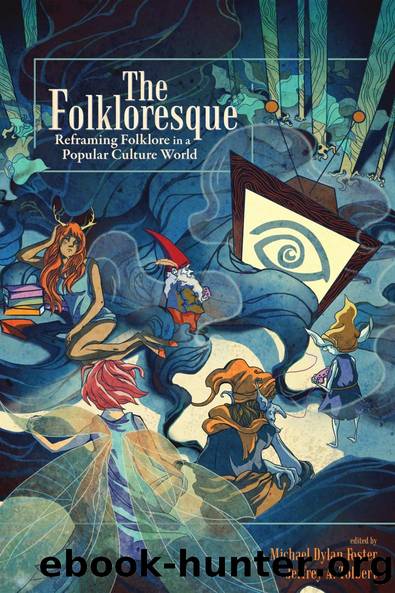The Folkloresque by Michael Dylan Foster Jeffrey A. Tolbert

Author:Michael Dylan Foster, Jeffrey A. Tolbert [Michael Dylan Foster, Jeffrey A. Tolbert]
Language: eng
Format: epub
Tags: Social Science, Folklore & Mythology
ISBN: 9781457197468
Google: X2voCgAAQBAJ
Publisher: University Press of Colorado
Published: 2015-11-02T05:46:08+00:00
Here Yuu is linking what is for him a real-world eventâthe disappearance of Keiâs nieceâto a particular type of urban legend. In the remainder of his essay, Yuu describes the urban legends that form the backdrop for the first and third games in the series, connecting the disparate stories of the Fatal Frame trilogy along folkloric lines.
The assimilation of these events into the genre of urban legend is a critical storytelling device: it enables the research that furthers the plot, providing important information to the protagonists; it also greatly heightens the fear experienced by the player, not only by forcing intellectual engagement with the supernatural events as depicted but by making them seem more plausible because they are already attested to in local folklore. Stories like these fictional legends âseem authentic because they appear in appropriate or familiar contexts, are juxtaposed with known folklore, or are bolstered with spurious scholarly citationsâ (Evans 2005, 119). Yuuâs essay perfectly illustrates the compelling and creative uses to which the folkloresque may be put.
But Yuu Asou is rare in the Fatal Frame universe in that his study of folklore does not ultimately lead to his own demise (although he does die, and like the other characters who study folklore, he returns as a ghost, albeit not a hostile one). This is in fact the most compelling aspect of Fatal Frameâs use of the folkloresque: not the folkloric content itselfâthe rituals and legendsâbut the way in which the games portray the people who study these phenomena. The folklorist emerges from the game world as a strangely ambivalent figure, marginalized (in more ways than one) but also, as I have already suggested, possessing dangerous knowledge and straying too close to the realm of hostile spiritual beings. Of course, the folklorist does not know the real truth underlying the strange customs he studies until itâs too late.
In the first game, the player learns that folklorist Ryozo Munakata moved into the abandoned Himuro Mansion after the failed ritual to study records left behind by the Himuro family. Eventually the supernatural events at the mansion lead to the deaths of Munakata and his family (âRyozo Munakataâ 2013). His notes, together with others found by Miku in the gameâs present, provide information necessary to understand the ghostly events in the mansion and to combat the evil spirits there. With the help of this knowledge the player is able to progress further into the mansion and eventually complete the failed ritual, laying the ghostsâ angry spirits to rest.
In Fatal Frame II, the player discovers that Seijiro Makabe, a folklorist who visited All Godâs Village to study the Crimson Sacrifice Ritual, was assisted by none other than Ryozo Munakata (prior to his eventual move to Himuro Mansion). It is revealed that Munakata is friends with a young man from the village, Itsuki, who has contacted him to ask for help in rescuing twin sisters Yae and Sae, the intended victims of the next ritual. The villagers welcome the folklorists into their homes,
Download
This site does not store any files on its server. We only index and link to content provided by other sites. Please contact the content providers to delete copyright contents if any and email us, we'll remove relevant links or contents immediately.
Cecilia; Or, Memoirs of an Heiress — Volume 1 by Fanny Burney(32022)
Cecilia; Or, Memoirs of an Heiress — Volume 3 by Fanny Burney(31436)
Cecilia; Or, Memoirs of an Heiress — Volume 2 by Fanny Burney(31380)
The Great Music City by Andrea Baker(30641)
We're Going to Need More Wine by Gabrielle Union(18606)
All the Missing Girls by Megan Miranda(14597)
Pimp by Iceberg Slim(13717)
Bombshells: Glamour Girls of a Lifetime by Sullivan Steve(13665)
Fifty Shades Freed by E L James(12886)
Talking to Strangers by Malcolm Gladwell(12814)
Norse Mythology by Gaiman Neil(12785)
For the Love of Europe by Rick Steves(11331)
Crazy Rich Asians by Kevin Kwan(8860)
Mindhunter: Inside the FBI's Elite Serial Crime Unit by John E. Douglas & Mark Olshaker(8664)
The Lost Art of Listening by Michael P. Nichols(7125)
Enlightenment Now: The Case for Reason, Science, Humanism, and Progress by Steven Pinker(6852)
The Four Agreements by Don Miguel Ruiz(6284)
Bad Blood by John Carreyrou(6255)
Weapons of Math Destruction by Cathy O'Neil(5801)
